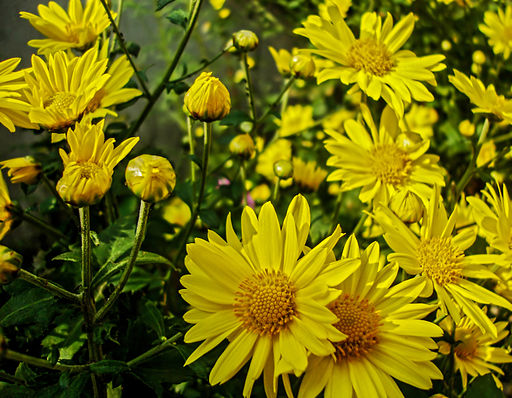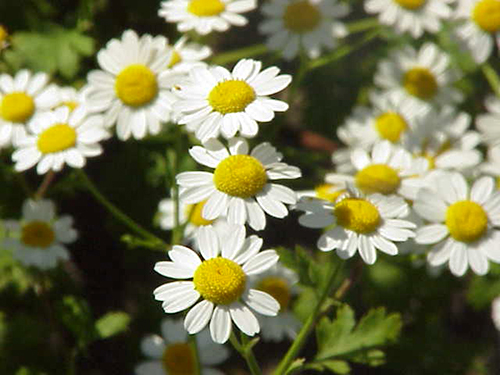When most people hear of the herb feverfew, they think migraines. While feverfew became popular in Great Britain in the ‘80s for treating this, it has been used far longer and for many more purposes than this. In fact, this herb is quite similar to the Chinese herb, wild chrysanthemum, and their common uses may make them somewhat interchangeable.
Feverfew (Tanacetum parthenium, Chrysanthemum parthenium, Pyrethrum parthenium; Asteraceae family) has a cool energy, bitter flavor and enters the Lungs, Liver, and Stomach. While the entire above-ground portion may be used, typically the leaves and flowers are given, especially the leaves for migraines. It has antipyretic, diaphoretic, carminative, purgative, bitter tonic, and anti-inflammatory properties.
In terms of treating migraines, the first feverfew treatment was chewing 2-3 of the fresh leaves daily. However, some reacted by developing mouth sores, or swelling of the tongue, mouth and lips. Today, many take the dried herb in capsule form instead and are able to reduce the frequency of their migraines.
Feverfew does not work for all types of migraines, however. I’ve seen it work best for those with Damp Heat in the Liver or Blood Stasis1, but not for those with deficient Blood or Yin.2 Overall, it works best for those with headache, heavy menstrual bleeding and pain, feeling hot, a bluish discoloration on the skin, or poor digestion.
According to Gazmend Skendiu in Herbal Vade Mecum (Herbacy Press, NJ, 2003), feverfew releases serotonin from blood platelets, which may in part explain its anti-migraine properties. Sharon Tilgner, N.D., in Medicines from the Earth (Wise Acre Press, Creswell, OR, 1999) states that feverfew decreases platelet aggregation, which could account for its Blood-moving properties that would also alleviate certain migraines.
Feverfew was traditionally used by the ancient Greeks to reduce inflammation and as an emmenagogue for menstrual cramps. The genus Chrysanthemum parthenium was employed and considered an important remedy for fevers. All the feverfew genuses have been used for colds, flu, digestive problems, headaches, nervous afflictions, pain due to poor circulation, coughs, wheezing, or difficult breathing. As well, the plant was applied topically to treat insect bites and its oil on arthritic pain.
Interestingly, the genus names of feverfew have changed many times but the common and species names haven’t. Note that one of the genus names is Chrysanthemum! In fact, Grieves in A Modern Herbal calls both Chrysanthemum suaveolens and C. maritime, “Sweet Feverfew.”
When you read about wild chrysanthemum below, you’ll see these traditional uses may well be applied now and that feverfew may still be a good choice for colds, fever, digestive problems, dizziness, nausea, vomiting, ringing in the ears (tinnitus), psoriasis, earaches, liver diseases, muscular tension, and more, especially in those with Liver Damp Heat or Blood Stasis (see footnote 1).
Dose: 3-9 g; infuse 1 tsp/cup water, drink 2-3 cups/day; 10-40 drops tincture 1-4 times/day
Precautions: pregnancy; do not use for migraines resulting from weakness or any deficiency); don’t take while on blood thinner medication or using any medications broken down by the liver; stop using before surgery. Those with an allergy to ragweed may have sensitivity to feverfew.

Wild chrysanthemum flowers (C. indicum; ye ju hua) are white and daisy-like as are those of feverfew, however they have a slightly colder energy, and although also bitter, they have an acrid flavor, and yet they too enter the Lungs and Liver. They are used to treat sore throat, red eyes, and skin conditions since they resolve toxins and reduce swelling. As well, they move Blood, like feverfew.
In general, wild chrysanthemum is a strong detoxifier used to treat hypertension, skin ailments, eczema, scrofula, and inflammation of the throat, eyes, and cervix. The entire above ground plant is used for toxic boils and swollen abscesses.
Chrysanthemum flowers (Chrysanthemum morifolium, Asteraceae family; ju hua Chinese) have a cool energy and bitter flavor, but are also somewhat sweet. They enter the Lungs and Liver. The larger flowers are used to cool the Stomach, as does feverfew. They have diaphoretic, antipyretic, anti-inflammatory, and antihypertensive properties. The yellow flowers are considered best by the Chinese, probably because they are also slightly sweet, which would ameliorate the bitter flavor and so extend their use to deficient Yin and uprising Yang conditions.
Chrysanthemum is included in many cold and flu formulas, including the well-known Yin Chiao Chieh Tu Pien, for headaches, fevers, colds, flu, sore throat, and pneumonia. It also treats red, painful, dry eyes, excessive tearing, blurry vision, dizziness, and spots in front of the eyes. The Chinese regularly drink chrysanthemum tea as a summer beverage for its refreshing taste and cooling properties.
Chrysanthemum is also used to calm the Liver, treating anger, irritability, dizziness, headaches, hypertension, and deafness, by pulling down the rising energy (called uprising Liver Yang). In order to use feverfew as a possible substitute for the yellow chrysanthemum flowers, it would need to be combined with an herb that nourishes Liver and Kidney Yin, such as marshmallow, which clears Heat and moistens.
Dose: 4.5-15g
Contraindications: do not use large doses in those with weakness; avoid if there’s diarrhea or coldness.
Overall, feverfew is a good substitute for the Chinese herb, wild chrysanthemum (C. indicum; ye ju hua), expanding its uses to treating sore throat, red eyes, and skin conditions. As well, it may be a valuable substitute for yellow chrysanthemum, too, if combined with an herb like marshmallow. In general, however, this is one more Western herb we can reclaim and begin using again according to its ancient tradition, for this herb has many more valuable applications than just for migraines
[1] Symptoms of Blood Stasis include sharp stabbing pains, bluish or purplish discolorations, numbness, certain lumps, masses, dark colored blood, large blood clots, tremors, swelling of the organs, and traumatic swellings. Symptoms of Liver Damp Heat include nausea, fullness of the chest and hypochondrium, jaundice, vomiting, fever, scanty dark urine, burning on urination, bitter taste in the mouth, abdominal distention, redness and swelling of the scrotum, vaginal discharge and itching, and a sticky yellow tongue coat.
[2] Symptoms of deficient Blood include dizziness, blurry vision, numbness, restlessness, anxiety, slight irritability, insomnia, scanty menses or amenorrhea, thinness or emaciation, dark spots in the visual field, dry skin, hair or eyes, lusterless, pale face and lips, tiredness, easily startled or overwhelmed and poor memory. Symptoms of deficient Yin include night sweats, malar flush (redness and burning heat along the cheeks and nose), burning sensation in the palms of the hands, soles of the feet and in the chest, afternoon fever or feelings of heat, restless sleep, dry throat or thirst at night, agitation, mental restlessness, dry cough, dry stools, and scanty dark urine.


Love this post! I’ve been thinking about these 3 herbs often lately. Thanks, Lesley!